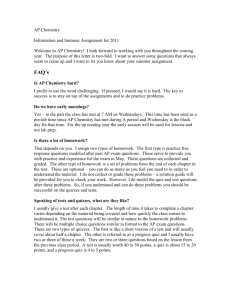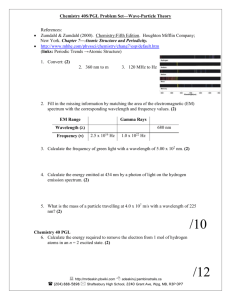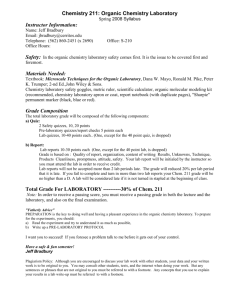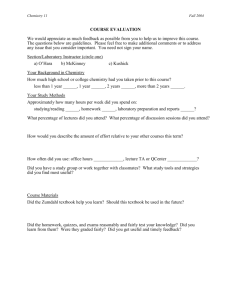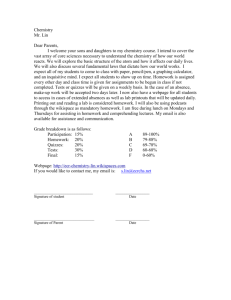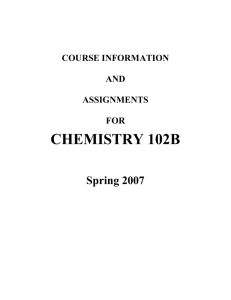Syllabus
advertisement
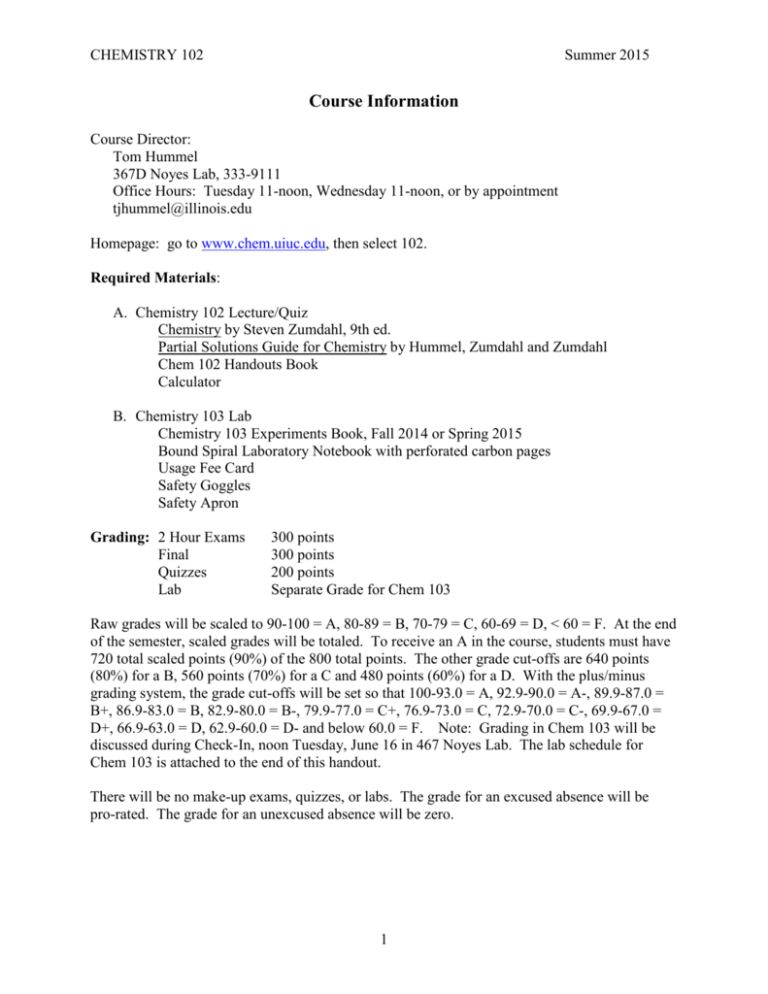
CHEMISTRY 102 Summer 2015 Course Information Course Director: Tom Hummel 367D Noyes Lab, 333-9111 Office Hours: Tuesday 11-noon, Wednesday 11-noon, or by appointment tjhummel@illinois.edu Homepage: go to www.chem.uiuc.edu, then select 102. Required Materials: A. Chemistry 102 Lecture/Quiz Chemistry by Steven Zumdahl, 9th ed. Partial Solutions Guide for Chemistry by Hummel, Zumdahl and Zumdahl Chem 102 Handouts Book Calculator B. Chemistry 103 Lab Chemistry 103 Experiments Book, Fall 2014 or Spring 2015 Bound Spiral Laboratory Notebook with perforated carbon pages Usage Fee Card Safety Goggles Safety Apron Grading: 2 Hour Exams Final Quizzes Lab 300 points 300 points 200 points Separate Grade for Chem 103 Raw grades will be scaled to 90-100 = A, 80-89 = B, 70-79 = C, 60-69 = D, < 60 = F. At the end of the semester, scaled grades will be totaled. To receive an A in the course, students must have 720 total scaled points (90%) of the 800 total points. The other grade cut-offs are 640 points (80%) for a B, 560 points (70%) for a C and 480 points (60%) for a D. With the plus/minus grading system, the grade cut-offs will be set so that 100-93.0 = A, 92.9-90.0 = A-, 89.9-87.0 = B+, 86.9-83.0 = B, 82.9-80.0 = B-, 79.9-77.0 = C+, 76.9-73.0 = C, 72.9-70.0 = C-, 69.9-67.0 = D+, 66.9-63.0 = D, 62.9-60.0 = D- and below 60.0 = F. Note: Grading in Chem 103 will be discussed during Check-In, noon Tuesday, June 16 in 467 Noyes Lab. The lab schedule for Chem 103 is attached to the end of this handout. There will be no make-up exams, quizzes, or labs. The grade for an excused absence will be pro-rated. The grade for an unexcused absence will be zero. 1 CHEMISTRY 102 Summer 2015 Course Format: Lecture and quiz sections will meet four times a week. In lecture, material from the text and from other resources will be presented and homework problems assigned by Tom Hummel. In quiz sections, an instructor will answer questions about lecture material, work homework problems and examples, introduce some new material, group work, and give quizzes. Selected homework problems will be collected and graded each week. Chem 103 labs will meet twice a week at noon – 1:50 p.m. on Tuesdays and Thursdays in 467 NL NOTES: 1. The discipline of chemistry and this course in particular demand that you take responsibility for your own learning. Major learning takes place during study and problem solving; the instructors are here to guide your efforts, but you must supply the initiative and hard work. 2. This is going to be a fast-paced course. Normally the course is fifteen weeks, but we shall be going through roughly the same material in eight weeks. 3. There will be four lectures and four quiz sections each week for Chem 102, and two labs (two hours each) per week for Chem 103. The lectures will be at 10 a.m. in 161 Noyes Lab (M-Th). The quiz sections will be at 9 a.m.(M-Th) in either 203 Noyes Lab (section AQ1) or 204 Noyes Lab (section AQ2). The labs will be from noon – 1:50 p.m. in 467 Noyes Lab on Tuesdays and Thursdays. 4. Attendance is very important in all facets of the course. One of the easiest ways to learn is to pay attention in lecture and quiz and take good notes. Also, grades of zero are assigned when labs and/or quizzes are missed without a good excuse. These have a real and adverse effect on semester grades. 5. The daily assignments for the semester are outlined at the end of this introductory information. Most of the assigned homework problems are from the Zumdahl text; a few of the assignments are from the Chem 102 Handouts book. In general, the reading assignment for that day should be done before lecture and the assigned problems attempted before quiz section the next morning. Look at all of the assigned problems, as most will emphasize different perspectives on a topic. In quiz section, the instructor will take questions on the previous night's assignment. During the semester, selected assigned homework problems will be collected. The overall grade on the collected homework will be worth two quizzes. All even numbered assigned Zumdahl problems will be the problems collected. The assigned Review Questions in the For Review section at the end of each chapter in the Zumdahl text will not be collected. These assigned Review Questions are for your use to make sure you understand some of the major topics covered in that chapter. 2 CHEMISTRY 102 Summer 2015 The Partial Solutions Guide provides detailed answers to the odd numbered questions and exercises from the text. Solutions to the assigned homework problems not solved for you in the Partial Solutions Guide are available in the Learning Center (230 Davenport Hall) for you to reference. 6. Most topics covered will be introduced in lecture. However, new material will also be covered in quiz section. You are responsible for all material covered in lecture and in quiz section. 7. A typical quiz section will start with a question/answer period on the assigned homework of the previous day and on lecture material. Next, new material will be introduced. Once or twice a week the instructor will give a 20 point quiz. In general, quizzes will be given on Mondays and Wednesdays throughout the semester. The quizzes will cover material gone over in lecture and in quiz section. 10 or 11 quizzes will be given during the summer. The 200 point grade in quiz section will consist of the top eight quizzes (two or three quizzes will be dropped) and the homework grade (equivalent to two quizzes). 8. The Chemistry Learning Center, 230 Davenport Hall, houses the computer terminals as well as tutoring facilities. At certain times, Chemistry 102 TAs and Chemistry 103 TAs are "on call" to answer questions and/or assist with problem solving; their office hours will be announced. 9. If you have difficulty with any part of the course, see me (Tom Hummel) or your TA promptly. My office hours are (in 367D Noyes Lab): Tuesday 11-noon, Wednesday 11–noon, or by appointment If I am temporarily unavailable, e-mail me (tjhummel@illinois.edu) and I will get in touch with you. 3 CHEMISTRY 102 Summer 2015 COURSE OUTLINE Date Topic Week 1 6/15 6/16 6/17 6/18 Introduction, Chapter 1 Material Dalton, Rutherford, Subatomic Particles Periodic Table, Nomenclature Moles, Molar Mass, Formula Determination Week 2 6/22 6/23 6/24 6/25 Chemical Reactions, Stoichiometry Electrolytes, Precipitation Reactions, Acid-Base Reactions Molarity, Solution Stoichiometry Oxidation-Reduction Reactions, Enthalpy Week 3 6/29 6/30 7/1 7/2 Gases Introduction Kinetic Molecular Theory, Real Gases Catch-up and Review Hour Exam I (9 a.m.) Week 4 7/6 7/7 7/8 7/9 No class Electromagnetic Radiation, Bohr Model Orbitals, Electron Configurations Periodic Properties Week 5 7/13 7/14 7/15 7/16 Bonding, Lewis Structures VSEPR, Polarity Hybrid Orbitals, Delocalization Intermolecular Forces, Physical Properties Week 6 7/20 7/21 7/22 7/23 Chemical Equilibrium Equilibrium Calculations, LeChatelier’s Principle Solubility Equilibrium, Common Ion Effect Precipitation Conditions, Dissolving a Precipitate 4 CHEMISTRY 102 Summer 2015 Week 7 7/27 7/28 7/29 7/30 Catch-up and Review Hour Exam II (9 a.m.) Introduction to Thermodynamics, First Law Enthalpy Determination Week 8 8/3 8/4 8/5 Bond Energies, Heating Curves Quiz Review 8/6 Reading Day 8/7 FINAL EXAM 8-10:30 a.m. 5 CHEMISTRY 102 Summer 2015 ASSIGNMENTS, SUMMER 2015 Date 6/15 Introduction, Chapter 1 Material Reading Z: 1.1-1.7, 1.9, 1.10, Appendix A1.1 Problems Z: 1: 19, 21-23, 26, 29, 31, 33, 35, 36, 37(a,b,e,f), 42, 54, 69, 72, 77, 79, 81, 83, 86, 87, 98, 99 R: 1: 1, 5-7, 9 6/16 Dalton, Rutherford, Subatomic Particles Reading Z: 2.1-2.6 Problems Z: 2: 20, 21, 23, 25, 41, 42, 57, 61, 67, 92 R: 2: 1(a, b), 4, 5 6/17 Periodic Table, Nomenclature Reading Z: 2.7, 2.8 Problems Z: 2: 28, 31, 32, 56, 69, 71, 73, 76, 78, 80, 85, 87, 93, 99 R: 2: 6-10 6/18 Moles, Molar Mass, Formula Determinations Reading Z: 3.1-3.7 Problems Z: 3: 27, 28, 37, 39, 65, 67, 77, 81, 82, 86, 89, 93, 94, 129, 130, 137, 140, 143, 175 R: 3: 1-6 6/22 Chemical Reactions, Stoiochiometry Reading Z: 3:8-3.11 Problems Z: 3: 33, 34, 96, 102, 106, 113, 116, 121, 124-126, 181 R: 3: 7-10 6/23 Solutions, Electrolytes, Precipitation Reactions, Acid-Base Reactions Reading Z: 4.1-4.6, 4.8 Problems Z: 13, 15, 24, 43, 45, 47, 50, 53, 66*, 67* For Exercises 4.66 and 4.67, only give the balanced formula equations. R: 4: 1-3, 6, 7 6/24 Molarity, Solution Stoichiometry Reading Z: 4.3, 4.7, 4.8 Z: 4: 31, 34, 37, 39, 56, 61, 74, 75, 77, 92, 95, 105, 106, 133, 136, 137 Problems R: 4: 4, 5, 8 Z = Zumdahl–9th Edition (only evens are collected) R = Review Questions in Zumdahl (not collected) 6 CHEMISTRY 102 Summer 2015 Date 6/25 Oxidation-Reduction Reactions, Enthalpy Reading Z: 4.9; 18.1; Handouts Book, p. 41 Problems Z: 4: 21, 79, 81, 83, 108; 6: 43, 45(a, b); 18: 20, 29 R: 4: 9; 18: 1 6/29 Gases Introduction Reading Problems Z: 5.1-5.5, Appendix A1.3 Z: 5: 23, 26, 28, 31, 46, 54, 55, 60, 67, 78, 79, 81, 85 91, 124, 134 R: 5: 1-5 6/30 Kinetic Molecular Theory, Real Gases Reading Z: 5.6-5.9 Problems Z: 5: 29, 32-34,107, 110, 111, 114 R: 5: 6-10 7/1 Catch-up and Review 7/2 HOUR EXAM I − 9 a.m. in 161 Noyes Lab 7/6 No Class 7/7 Electromagnetic Radiation, Bohr Model Reading: Z: 7.1-7.5 Problems: Z: 7: 20, 24, 45, 48, 64, 65, 67, 140, 141 R: 7: 1-3 7/8 Orbitals, Electron Configurations Reading: Z: 7.7-7.11 Problems: Z: 7: 28, 76, 80, 83, 84, 89, 91, 93, 98, 100, 132, 145, 148; 8: 46 Handouts Book, p. 61: Ion configuration problems at bottom of page. R: 7: 6-8 7/9 Periodic Properties Reading: Problems: 7/13 Bonding, Lewis Structures Reading: Problems: Z = Zumdahl–9th Edition (only evens are collected) Z: 7.12-7.13; 8.4 Z: 7: 105, 107, 110, 114, 115, 120, 125, 149, 150; 8: 21, 41, 52, 127 R: 7: 9, 10; 8: 2 Z: 8.1-8.3, 8.9-8.12 Z: 8: 16, 17, 27, 34, 35, 37, 38, 48, 84, 85, 87-91, 94, 97, 107, 134 Handouts Book, p. 70: Complete the Lewis structures for the organic compounds listed on the bottom of this page. R: 8: 1, 5, 6 R = Review Questions in Zumdahl (not collected) 7 CHEMISTRY 102 Summer 2015 Date 7/14 VSEPR, Polarity Reading: Problems: Z: 8.2, 8.3, 8.13 Z: 8: 20, 40, 113-120, 121, 124, 126, 157 R: 8: 8-10 7/15 Hybrid Orbitals, Delocalization Reading: Z: 9.1, 9.5 Problems: Z: 9: 6, 9, 11, 12, 21, 22, 27, 28, 31, 39, 61, 66, 67, 87 R: 9: 1-4, 10 7/16 Intermolecular Forces, Physical Properties Reading: Z: 10.1, 10.2, 10.8 (vapor pressure discussion only) Problems: Z: 10: 12-14, 21, 27, 35, 37, 39, 41, 111, 132 R: 10: 1 7/20 Equilibrium Reading: Problems: Z: 13.1-13.4 Z: 13: 11, 13, 14, 21, 23, 25, 27, 29, 33, 35, 37, 38, 43 R: 13: 1-5 7/21 Equilibrium Calculations, LeChatelier’s Principle Reading: Z: 13.5-13.7 Problems: Z: 13: 15, 16, 20, 28, 39, 41, 47, 49, 51, 57, 61, 63, 64, 68, 69, 80, 83, 90 R: 13: 6-10 7/22 Solubility Equilibrium, Common Ion Effect Reading: Z: 16.1 Problems: Z: 16: 8, 11, 19, 22, 25, 30, 35, 36, 39, 40, 43, 83 R: 16: 1-3 7/23 Precipitation Conditions, Dissolving a Precipitate Reading: Z: 16.2, 16.3 (general information only) Problems: Z: 16: 15, 51-53, 56, 57, 59, 75, 76 R: 16: 5, 6 7/27 Catch-up and Review 7/28 Hour Exam II – 9 a.m. in 161 Noyes Lab Z = Zumdahl–9th Edition (only evens are collected) R = Review Questions in Zumdahl (not collected) 8 CHEMISTRY 102 Summer 2015 Date 7/29 Introduction to Thermodynamics, Heat, Work, Internal Energy, First Law Reading: Z: 6.1-6.2 Problems: Z: 6:13, 32-34, 41-43, 46, 49, 50, 97, 100, 124, 130 R: 6.1-4 7/30 Enthalpy, Calorimetry, Hess’s Law, Standard Enthalpies of Formation Reading: Z: 6.2-6.6 Problems: Z: 6: 18, 19, 52, 56, 57, 62, 65, 67, 68, 72, 75, 78 79, 86, 112 R: 6.5-9 8/3 8/4 Bond Energies, Heating Curves Reading: Z: 8.8; Figure 10.42, p. 488 Problems: Z: 8: 23, 65, 68, 71, 73, 75, 76; 10: 23, 95, 96, 99, 100, 118 R: 8.4 Quiz 8/5 Catch-up, Review 8/6 Reading Day 8/7 FINAL EXAM - 8-10:30 a.m. in 161 NL Z = Zumdahl–9th Edition (only evens are collected) R = Review Questions in Zumdahl (not collected) 9 CHEMISTRY 102 Summer 2015 LABORATORY SCHEDULE CHEMISTRY 103 SUMMER 2015 Date Experiment June 16 Checking into the Laboratory June 18 Lab 1: Density and Data Analysis June 23 Lab 2: Determining the Composition of a Sugar Solution June 25 Lab 3: Beer’s Law and Food Dyes June 30 Lab 4: Spectrophotometric Analysis of Lemon-Lime Kool-Aid July 2 No Lab July 7 No Lab July 9 Lab 5: The Stoichiometry of Baking Soda July 14 Lab 6: Determining the Molar Mass of an Unknown Compound July 16 Lab 7: Calorimetry and Enthalpies of Solution July 21 Lab 10: LeChatelier’s Principle July 23 Lab 11: Determining the Value of an Equilibrium Constant for a Chemical Reaction July 28 No Lab July 30 Lab 9: Calorimetry and Hess’s Law August 4 No Lab 10
